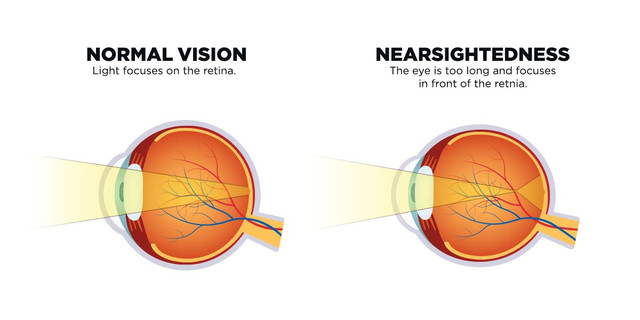If you are nearsighted, you know how inconvenient it can be. You may have to squint to see things far away, and you may not be able to participate in some activities because you can’t see well enough. If you are tired of dealing with your nearsightedness, consider getting LASIK surgery. In this blog post, we will discuss everything you need to know about LASIK for nearsightedness. We will talk about the benefits of the surgery, the risks involved, and what to expect after the procedure is completed.
Contents
What Is Nearsightedness?
 Nearsightedness, or myopia, is a refractive error of the eye in which distant objects appear blurry while close objects are clear. This occurs when the eyeball is too long or when the cornea, the clear front surface of the eye, has too much curvature. As a result, light rays entering the eye focus in front of the retina, the light-sensitive layer of tissue at the back of the eye, rather than on the retina. This causes distant objects to appear blurry.
Nearsightedness, or myopia, is a refractive error of the eye in which distant objects appear blurry while close objects are clear. This occurs when the eyeball is too long or when the cornea, the clear front surface of the eye, has too much curvature. As a result, light rays entering the eye focus in front of the retina, the light-sensitive layer of tissue at the back of the eye, rather than on the retina. This causes distant objects to appear blurry.
Nearsightedness is a common condition that affects an estimated 30% to 40% of Indians. It usually develops during childhood and often runs in families. There are two types of nearsightedness: simple nearsightedness and degenerative myopia.
Simple nearsightedness, or non-degenerative myopia, is the most common type. It occurs when the eyeball grows too long during childhood. Degenerative myopia, or malignant myopia, is a rarer form that develops in adulthood. It is caused by a combination of genetic and environmental factors. It is important to get treatment for your condition.
Is Lasik For Nearsightedness Helpful?
Yes, LASIK can be helpful for people who are nearsighted. Nearsightedness, or myopia, is a common refractive error that causes distant objects to appear blurry. If you’re nearsighted, LASIK can improve your vision by correcting the shape of your cornea.
Generally, Lasik is a good option for people who:
- Are at least 18 years old
- Have had a stable glasses or contact lens prescription for at least two years
- Don’t have any other eye problems, such as cataracts
It is a surgery that is widely considered to help your get rid of glasses. In many cases, LASIK can improve your vision to a point where you do not need glasses or contacts for everyday activities. However, like any surgery, there are risks involved. It’s important to discuss the risks and benefits of LASIK with your doctor before making a decision.
How Nearsighted Is Too Nearsighted For Lasik?
 There is no definitive answer to this question, as each individual case is unique. However, a general rule of thumb is that if your nearsightedness is so severe that you cannot see clearly even when wearing glasses or contact lenses, then Lasik may not be the best option for you.
There is no definitive answer to this question, as each individual case is unique. However, a general rule of thumb is that if your nearsightedness is so severe that you cannot see clearly even when wearing glasses or contact lenses, then Lasik may not be the best option for you.
Another factor to consider is the stability of your vision. If your vision has been stable for at least two years, you are more likely to be a good candidate for Lasik. It is also important to have realistic expectations about what Lasik can and cannot do. Lasik can correct your vision so that you no longer need to wear glasses or contact lenses, but it will not necessarily give you perfect 20/20 vision.
You should also be aware of the potential risks and complications associated with Lasik surgery. With an informed decision, you can weigh the risks and benefits of Lasik and decide if it is the right choice for you.
How Does Lasik For Nearsightedness Work?
The procedure of Lasik is very simple. First, the eyes are numbed with eye drops, and a special instrument is used to create a small flap in the cornea. Then, an excimer laser is used to reshape the cornea. The flap is then replaced and the eyes are allowed to heal.
Because the condition of nearsightedness is caused by a misshapen cornea, Lasik is able to correct it by reshaping the cornea. This will allow light to be properly focused on the retina, resulting in clearer vision. It is believed that Lasik can correct up to -12 diopters of nearsightedness.
Therefore, if you are considering Lasik for nearsightedness, you can be assured that it is a safe and effective procedure. It has a high success rate and can provide you with a better vision.
What Are Some Benefits?
Well, when you get Lasik for nearsightedness, you can finally ditch those pesky glasses or contact lenses! Not to mention, the surgery is usually pretty painless and has a very quick recovery time. Plus, it’s been around for a while now so the technology is pretty advanced and safe.
In addition, there are other benefits as well, these are:
- You’ll have a clearer vision and be able to see things more sharply
- Distance vision will be improved
- Fewer risks of developing other eye problems later on in life
- You can participate in activities that you may have avoided before due to your poor vision (e.g. swimming, hiking, etc.)
So, as you can see, there are plenty of reasons to consider Lasik for nearsightedness. But of course, like with any surgery, there are also some risks involved that you should be aware of before making a decision.
What Are Some Risks And Complications?
 As with any surgery, there are certain risks and complications associated with LASIK. It’s important to discuss these with your doctor before undergoing the procedure. Let’s discuss both below:
As with any surgery, there are certain risks and complications associated with LASIK. It’s important to discuss these with your doctor before undergoing the procedure. Let’s discuss both below:
Risks
There are some common risks that can occur, such as:
- Glare or halos around lights
- Night vision problems
- Under-correction (meaning you still need to wear glasses or contact lenses)
- Over-correction (meaning you no longer need to wear glasses or contact lenses, but your vision is not perfect)
The most common risk from LASIK is dry eye. This can usually be treated with artificial tears or other medications. Some people may experience more severe dry eyes that can last for several months.
Complications
One possible complication is called “flap slippage.” This is when the thin flap of tissue that is created during the surgery moves out of place. If this happens, you may need to have another surgery to fix it.
Very rare complications from LASIK can include:
- Corneal infection
- Glaucoma
- Detached retina
These complications are usually treatable if they are detected early. So you can see why it’s important to have regular checkups with your eye doctor after you have LASIK.
With an accurate pre-operative evaluation and good follow-up care, most people who have LASIK surgery experience little to no problems. If you are considering LASIK surgery, be sure to discuss all of the risks and complications with your doctor beforehand. This way you can make an informed decision about whether or not the procedure is right for you.
How Long Does Lasik Last For Nearsightedness?
There are usually myths around this topic, with some people believing that vision changes after LASIK are only temporary and vision will return to its original state within a few years. However, this is not the case. In fact, most patients report long-term success with their vision following LASIK.
Generally, Lasik for nearsightedness is permanent which means that you will not have to worry about your vision deteriorating or needing to undergo another surgery in the future. However, it is important to note that there are some cases where vision may fluctuate or degrade over time.
This usually occurs in patients who experience significant changes in their lifestyle or health after their procedure. For example, if you develop a condition that affects your eyesight, such as diabetes, it is possible that your vision may worsen over time. Additionally, if you work in a job or participate in activities that put a lot of strain on your eyes, you may also experience some degradation in your vision over time.
Overall, however, the majority of patients who undergo Lasik for nearsightedness report satisfaction with their vision for many years after the procedure. If you are considering Lasik, be sure to speak with your eye doctor about the potential risks and benefits to see if it is the right choice for you.
Conclusion
In a nutshell, Lasik for nearsightedness can be an excellent way to improve your vision. By working with a skilled surgeon, you can achieve excellent results. Be sure to ask plenty of questions and do your research to ensure that you are making the best decision for your needs. With proper care and follow-up, you can enjoy a clear vision for years to come.
EyeMantra also offers the most advanced Lasik options including PRK, Femto Lasik, SMILE surgery, Standard lasik, and Contoura vision. If you have any questions on lasik surgery, lasik surgery cost and lasik procedure, call us at +91-9711116605 or email at eyemantra1@gmail.com.
Free Lasik Surgery by EyeMantra Foundation for needy people.


